Posts with tag 'Article':
Sokpop Collective game recommendations!
Posted on 2025-01-24 21:01
The idea behind Sokpop Collective is that they are a team of indie developers who release small games on a set schedule, with the authors cycling to give each member time to breathe between releases. They've put out over 100 games to date, and while the games were a Patreon thing initially, they seem to (all?) be on Steam by now. I bought the Sokpop Super Bundle on Steam a bit before the end of the year after Hideko was recommended to me, and have been going through the games there since.
The quality of the releases varies a lot (in part because initially the release rate was monthly, i.e. *really* fast); there were some really solid and inspiring games in there, and now that I've gone through them all (+ a couple Sokpop entries not in the Super Bundle), I thought I'd give some recommendations (and anti-recommendations for entries that e.g. didn't work at all). Here goes!
My favourites
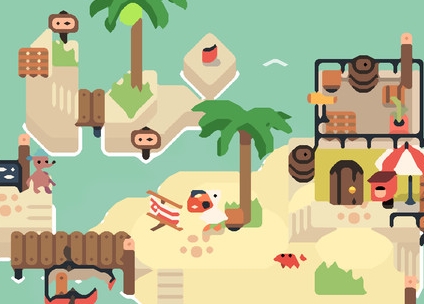
- Pocket Watch
Extremely charming puzzle adventure where you play through the same day multiple times, observing how different characters act and slowly piece together a plan on how to get everything you need to be done in time.
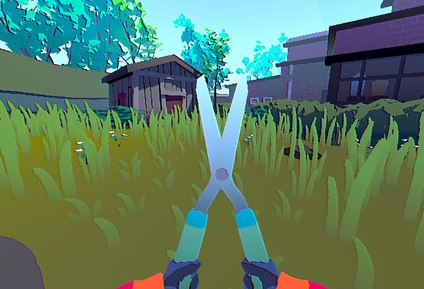
- Grunn
Mysterious gardening game with puzzle-solving & exploration. Very atmospheric and inspiring. Contains a *ton* of jumpscares, though, so be wary of that.
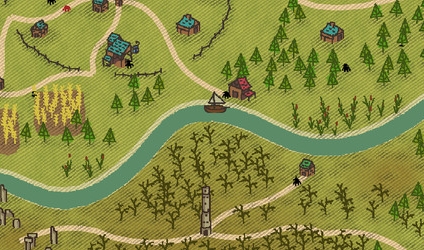
- Apocalich
I love maps, and this game sold me over just by the action taking place on a cool fantasy map of sorts. A fairly simple action adventure with semi-turn-based combat, but the fact that you can see things happen on the map as you do your thing elevates it a lot!
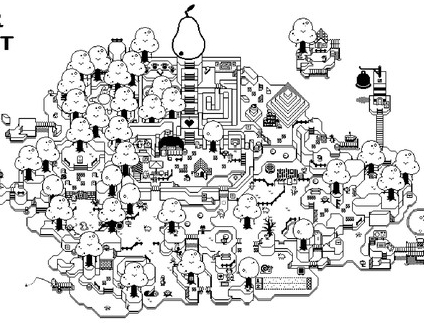
- Pear Quest
This feels in some ways like a prelude to Pocket Watch. Has the same map-based selling point for me as Apocalich. The gameplay is very simple adventuring & puzzle solving, again, but the game's very charming and fun to romp through.
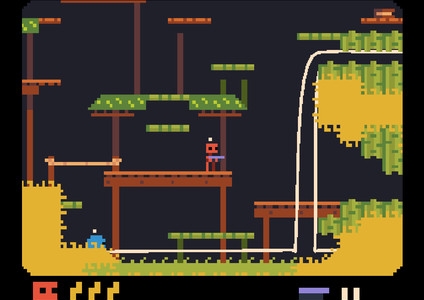
- bobo robot
A very standard, small-scale metroidvania. Short but sweet.
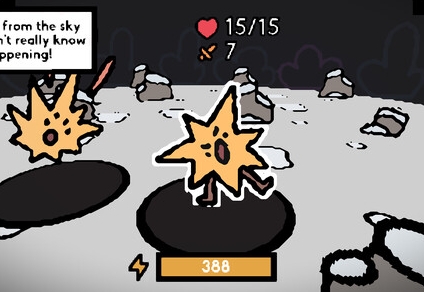
- Springblades
Simple but enjoyable fantasy adventure with a turn-based combat system. Surprising amounts of content and some intriguing boss designs, alongside a sweet visual style. The music is also really cool and somewhat unusual for the genre, I'd say.
Games I enjoyed a lot
- Heliopedia
One of several games about combining elements to make a barren world habitable, create life and eventually bring a society into existence. I didn't get too far in this, but I love the way the game feels and looks, and it was fun to try to get different kinds of worlds into action.
- helionaut
Shares visual similarities with Heliopedia, but is a space-exploration adventure in a procedurally-generated world. Find pieces for your ship and upgrade them, collect resources and fight robots. Initially I enjoyed this greatly, but the slightly finicky controls and samey gameplay loop lessened my interest over time a bunch. Still a great time.
- WILD-9
Collect pieces for your broken ship in a space robo-westerner-esque world. I love the general vibe here, and the game reminded me of a bunch of projects I've made in the past & want to work on in the future (namely Apocalypse Adventure & Badland Quest).
- labyrinth
Small platforming adventure in mysterious ruins. A nice display of Sokpop's Game Maker -based 3D engine, although the layering issues present caused a bunch of readability issues here. Gives me ICO vibes.
- Goblet Cave
Delve deep into a cave and rescue spelunkers and rubies, eventually reaching the golden goblet at the bottom. Very janky, but hit my interests spot-on; I love planning my route and navigating & mapping out a cave system. I guess it's telling that Excavatorrr and CWOUN do a very similar thing, haha.
- Hideko
Another combine-elements-to-create-life kind of thing, this time in a more puzzly presentation. Charming and fun to play with, although the game seemed to want me to create marble mazes for my own fun which I didn't really care for.
- Frog's Adventure
Cute and fun point-and-click-esque adventure with light puzzling. Features one of the more unexpected plot resolutions I've seen in a game like this!
- Luckitown
Roll dice to get resources, use resources to build structures that either improve your defense, deal damage to attackers or provide other resources. The gameplay is a whole bunch of fun, but the difficulty gets *very* high by the time you get to the end of the second season (out of 4).
Games I enjoyed
- Klym
Climb around a town to return all baby ducks to their mother. The controls are a bit janky and I had some issues with the scrolling, but otherwise had a good time. Short & sweet.
- Grey Scout
Rescue prisoners from cages and return them safely to your boat. The sneaking mechanic is quite forgiving, which makes the game much more approachable. Quite short but I enjoyed it a bunch.
- Moeras
Hunt a large beast on a battlefield armed with just your trusty bow. Very bare-bones but intriguing.
- Berry People
Not part of the Super Bundle. A short, cute Pokémon Snap -esque exploration game. I wish the game did a *bit* more with the concept, since as it is the experience is very simplistic and all your photos will be of similar-looking berry people, but I had a cozy time with it all the same.
- Soko Loco Deluxe
(I played Deluxe, but only the original soko loco is in the Super Bundle.) Build train tracks to create supply lines to fulfill the goal in each level. I appreciate that the game doesn't push you too hard to do this super efficiently or quickly (at least in the parts I played), but this also opens the door to some rather tedious optimizing since you can tear up tracks you've laid without losing anything. Still a fun time, though!
- Stacklands
Also not part of the Super Bundle. Buy boosters, place cards representing animals and resources onto each other to get other resources, learn new recipes. I enjoyed the game and it was fairly addictive, but the manual mousework needed became a lot and the booster-based card-unlocking method got a bit tedious over time. Still solid.
- Aran's Bike Trip
A mildly interactive travelogue of a two-day bike trip. Features a nice map view of the route taken and beautiful photos of things seen on the way. I love the scenery and I love biking, so I enjoyed following along a lot.
Honourable mentions
- Sunset Kingdom: Fun little kingdom-building strategy game. Takes a lot of time to get going, though.
- Ballspell: A solid implementation of the concept popularized by Montezuma('s Revenge?) Not too exciting but a solid game nonetheless.
- Ginseng Hero: Nice little action adventure in a bug world.
- The Hour of the Rat: Infiltrate a castle & assassinate the emperor. Neat idea marred by fairly janky movement.
- Tile Tale: Push tiles on a grid to rectangle patterns to earn more tiles and unlock new ones. Enjoyable but a bit mindless?
- Pilfer: Steal goods in a town as a sneaky thief. I didn't get too far but enjoyed what I saw.
- Blue Drifter: Assassinate people in a sci-fi setting. There's very little game here, but I enjoyed the presentation a lot.
- Uniseas: Real-time strategy where you command pirates trading and pillaging. Very cool but also very overwhelming, with there being 3 opponents doing their stuff all the time.
Games that didn't work or seemed otherwise off
- Tomscape: Didn't seem to work at all for me.
- Zoo Packs: Didn't seem to work at all for me.
- Rock Paper Sock: Didn't seem to work at all for me.
- King of the Sandcastle: Seemingly a multiplayer-only game with no players left.
- Botanik: Seemingly a gardening game where all players exist on the same map, kind of. No players left, so all I saw was a sea of greenhouses with dead plants.
- huts: You walk in a small 3D forest but can't seemingly do anything.
- visser: You can catch a fish, but other than the cute presentation there didn't seem to be a goal or much to do here.
- Frog Struggles: It seems that there's more to this game, but after playing for a bit I couldn't understand how to progress beyond awkwardly flying around or why I could sometimes pick up cherries and sometimes not.
- Di-Da-Dobble: Yahtzee but without a goal and with n-of-a-kind being the only recognized hand. Being able to slam the table to alter the result was cute, though.
- Wamu Wamu 2: The game seemed to softlock both times I tried to play.
- vissekom: Watch a fish in a fishbowl. Every couple minutes a 3D prop drops into the bowl. From what I could see, there was no further interactivity other than clicking on stuff to make them bounce inside the bowl, but the achievements seem to imply I missed something.
- Pupper Park: You're a dog and spend ~15 minutes in a dog park with other dogs. There are a couple minigames to play but overall it didn't feel like there was much to do.
Overall, I had a lot of fun going through these! It was nice to have a collection of games where I don't have a particular internal pressure to really dedicate a lot of time to each one, so I could do a little taste test and then play the ones I especially enjoyed further.
It feels like the very barebones/unfinished releases make more sense in a Patreon-based release model because the idea is that people support an artist instead of paying for a given product; putting all these games on Steam changed the equation in my mind a bit, which is a bummer when it comes to the weaker releases. Oh well; apart from a couple exceptions I did find it intriguing to check out even the less refined stuff. Thank you for making all these neat games, Sokpop Collective!
 11
11  7
7  3
3
2024 in review
Posted on 2024-12-31 01:44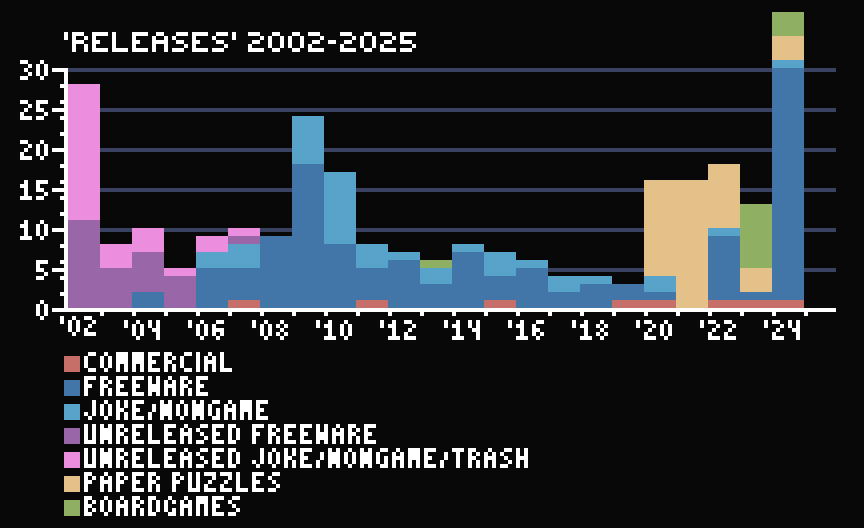
Here we are again, at the end of the year. I'm looking at the 2023-in-review post as I'm writing this, and right from the get-go I can notice a clear difference in one aspect: 2024 was my most productive year ever, if we calculate that purely by the number of videogames released. Saying this feels somewhat disingenuous due to the fact that most of the Covemountlikes that make up the high release rate were extremely tiny, spur-of-the-moment things, with multiple taking less than a full day to get done. On the other hand, several of the games that account for the previous record unusually-active year, 2009, were also made in just a couple weeks, so in that sense it wouldn't be fair to consider this year "cheating" in some way. I guess with a metric like this the biggest problem is that larger releases that take their time will get unfairly little attention since they fill just a single increment on the bar chart, just like everything else. Oh well.
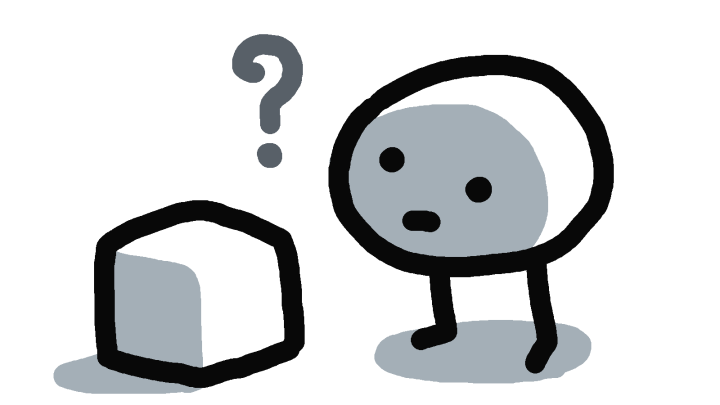
Alongside the onslaught of Covemountlikes this year saw a couple other releases. Out of those the most notable videogame release was A Solitaire Mystery, although I still intend to get back to it to add some more solitaires and to polish things up further so I'm not quite done with the project. At this point it might make sense to note that ASM was chosen to be showcased at the Experimental Games Showcase at GDC 2025! I won't be participating in person due to the travelling required etc, but it's cool to be accepted in any case. :)

Other than videogames, I made a couple boardgames and paper puzzles. The latter was very much sidelined for this year, although I did occasionally spend time trying to come up with new genres, to no avail. In the boardgame department, Royal Jelly actually garnered some additional interest, as evidenced by 2 people making their own sets (first, second)! This is also the first year I ever entered a boardgame design contest, although my game, Stroll & Hike, didn't fare too well. In fact I made another boardgame for a different contest near the start of the year, but a period of anxiety caused me to miss the deadline and I haven't polished the game up for release yet.
In terms of things not related to releasing creative works, a big change for me this year was that I joined a small group of streamers and we've organized a whole bunch of collaborative streams throughout the year. Thanks to everyone in the possibly-unnamed crew for their kindness!
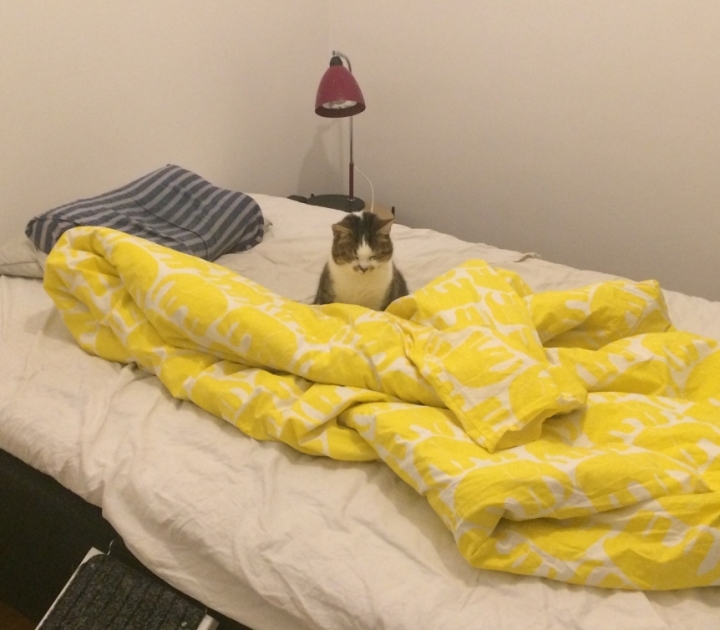
Another big change was the introduction of Fondue the cat to my life. Apart from me having problems with treating her asthma with an inhaler, I'd like to say that her time here has been positive and she's gained a lot of courage and received a lot of care. Although 2 weeks ago she did swallow a salted peanut and ended up needing surgery for it, the poor cat. She has recovered very well and next Thursday she'll get the wound-licking-prevention jumpsuit off, which I'm sure she'll be very happy about. Vilma has also been doing mostly great, except that her knowledge of being able to demand attention has given me some frustration over the year, haha.
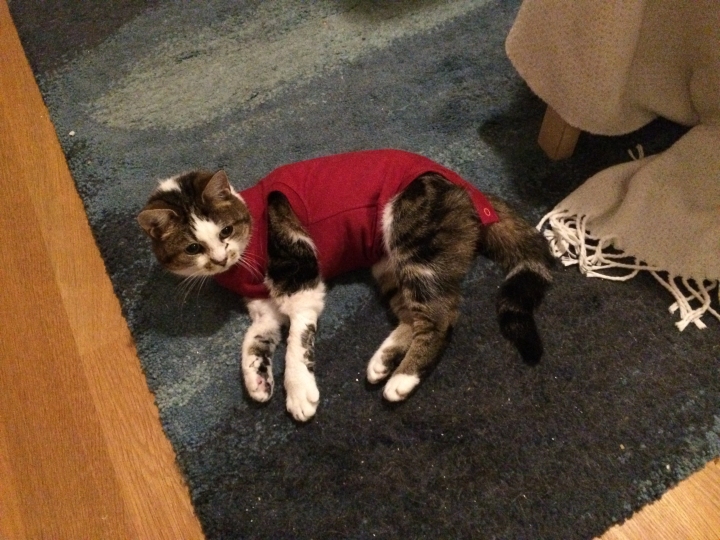
Fondue's not the only one who required medical attention near the end of the year - a couple days ago I fell over after stumbling on some cobblestones and fractured my right thumb. After the cast was put in place the finger hasn't hurt that much, and surprisingly enough I was able to put the final covemountlike together in spite of it. Still, that's 6 weeks of recovery ahead of me, and I actually have to go back to the hospital for additional X-rays because apparently the finger might not be entirely right still. Moral of the story: falling over can be nasty!
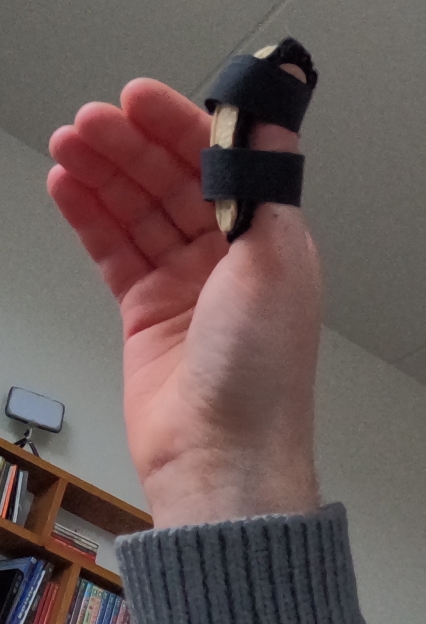
A thing that is big for me but probably not anyone else is that I moved my website into a completely new era of design, creating a more dynamic listing for my games, moving my blog away from Wordpress and bringing my art from DeviantArt to my own webspace. It was nice to set this stuff up, and I hope some people other than just me find utility in the website. (Although Hostmonster just announced merging with Bluehost and advertising their AI tools, so we'll see if I'll suddenly need to migrate the whole thing elsewhere, urgh...)
Might that be about it? Next year I think I'll try to concentrate more on slightly larger projects now that this year was themed heavily after making a ton of extremely tiny things. It'd be nice to finally manage to paint again, too, but we'll see about that. ESA2 and Planet Keke will stay on the docket, at least. Happy new year!
 11
11  92
92
Tags: Games, ESA 2, Planet Keke, Covemountlikes, Small games, Browser games, Other, Regular updates, Pets, Article, Boardgames
2023 in review
Posted on 2024-01-07 08:17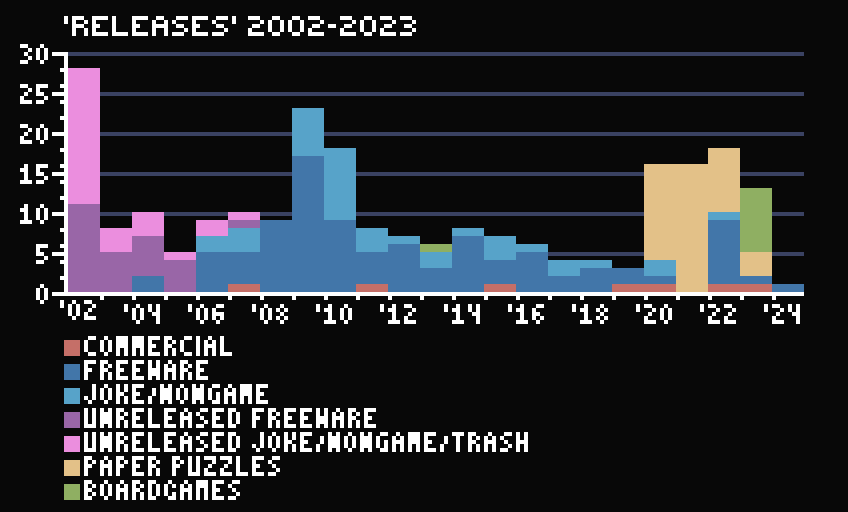
So! Another year has passed. After 2022’s productivity, 2023 followed more on the footsteps of 2020 and 2021 in that I got very very few games released. However, this comparison feels somewhat unfair because I was still working on multiple projects throughout the year, and Mobile Suit Baba was the fruit of those efforts, ending up being quite a bit more ambitious than I initially planned. I also worked on Noita again, adding some more content. Thanks to Petri & Olli for letting me do that!
2023 also saw me getting into boardgame development more seriously. I’ve been dabbling with trying to make my own boardgames/cardgames since childhood (I have about 5 different imitations of Magic: the Gathering & the Pokémon Trading Card Game I made back then stashed in a cupboard), and Petri Purho (from the Nolla Games team) and Erik Svedäng (developer of Blueberry Garden & Else Heart.break()) inspired me further by making boardgames at various game jams. However, during adulthood I’ve never really gotten past the initial stages of design due to impatience, lack of skill, and other factors. Me and Petri developed 2 boardgames together somewhere around 2013, but the first time I got close to actually releasing something was with Piiri in 2020, although that too went unfinished at the time.
Considering the above, me being able to develop so many boardgames to a state where I felt confident enough to put them available online last year felt really nice! Mostly the boardgame design motivation came from procrastination regarding videogame development, but I can’t complain too much about that since the end result was still creative work being done on something I was happy with. The impatience and lack of skill are still present, though, and as such my boardgames have stayed very carefully in the land of 2-player abstracts. Maybe this year I’ll go further?
2023 was also the year of books for me. I started trying to read more in 2022, and once the habit was formed, it was great to get through a lot of new stuff after years and years of re-reading the sam books over and over. In total I read 24 titles last year, although some were very short affairs.
Anyway, here’s the total list of stuff I released last year:
- Baba Files Taxes
- Cylinders of the Wise
- Obsidian Sentinels
- Malsymmetric (technically unfinished because I wasn’t happy with the design)
- Equal measures (paper puzzle)
- Piiri (mostly designed in 2020)
- Kepi
- Elder Dance (technically unfinished because the rules were broken)
- Kurote
- Gnome Thicket
- DIAGORT
- Flatdog Scuffle
- Mobile Suit Baba
- LITSilly (paper puzzle)
Last but not least, 2023 was also the year I finally got a pet, although a better term might be that a pet was got-ed at me. Vilma has been getting more used to me and my apartment, and lately I seem to have figured out what kind of scratching she likes, and she has also started to spend more time lying next to me while I sleep. It’s funny how years-long plans to get a dog turned out like this. Oh well!
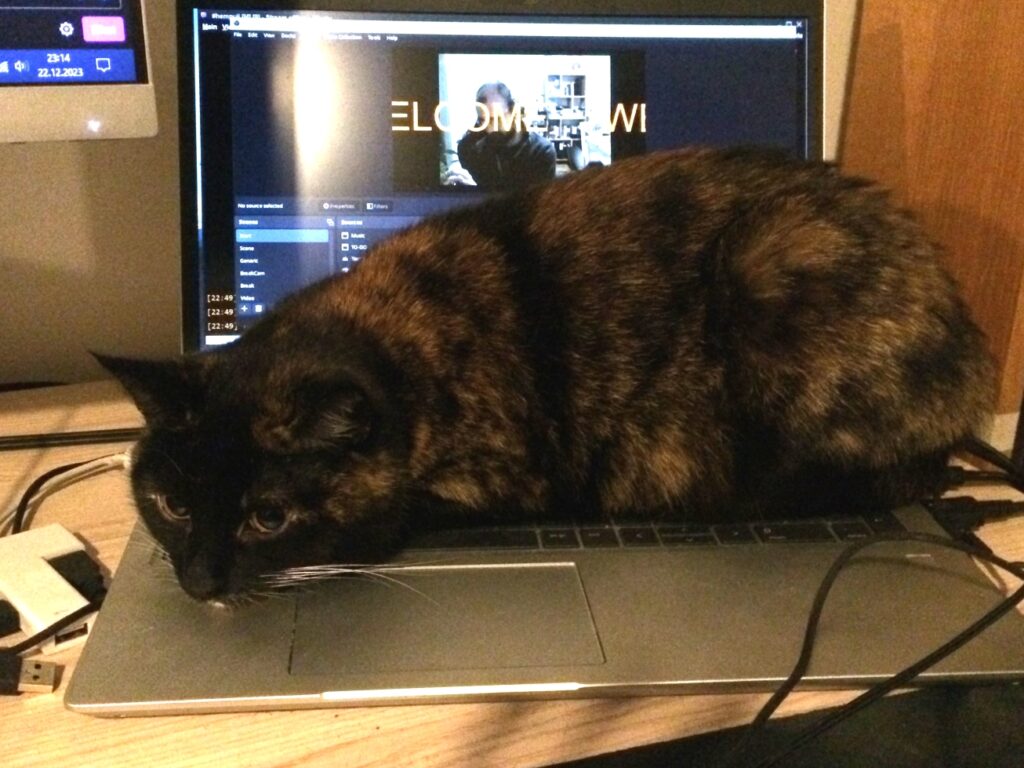
For 2024, I have plans to try to release more tiny games like in 2022. However, ESA 2 and Planet Keke are on the table still and especially ESA 2 needs all the attention I can give, so I’ll have to be mindful of that when I decide to dedicate time to sideprojects. I’m sure something’ll work out, though.
Off to a new year we go!
[Wait, nothing about the graduation in this??]
 2
2
Tags: Games, Baba Is You, ESA 2, Planet Keke, Small games, Boardgames, Paper puzzles, Noita, Other, Regular updates, Pets, Article
2022 in review(?) Tags: Games, Small games, Baba Is You, ESA 2, Happenings, Plans, Other, Old games, Browser games, Paper puzzles, Streaming, Article, Art La-Mulana Classic dev commentary Tags: Games, Old games, Other, Article Some notes about motivation Updatedsds Tags: Games, Baba Is You, GDC, Happenings, Other, Noita, Plans, Article Questions regarding platformer development The year 2015 Tags: ESA, ESA 2, Games, Plans, Other, Happenings, Streaming, Regular updates, Article Environmental Station Alpha post-release thoughts Tags: Games, ESA, Other, Plans, Article
Posted on 2022-12-30 03:27
Ok! I’ve been promising a general “what’s going on” post for a while now, and I guess it’s time to write exactly that. When this year started, I had a couple specific plans for how I’d handle my game development throughout the year (and in some cases onwards from there):
- I intended to start a more structured weekly schedule, sleeping times included, in an effort to both differentiate my free and work time better and to get my terribly unstable daily rhythm under control.
- I planned to make a small game every month for a total of 12 small games, both as a way to try out this system I had first seen used by Petri Purho in… 2007, was it? and in order to take a mental break from Baba Is You and other large, multi-year projects that had been on my mind over the past years.
So how did all this turn out? Not very well. The structured schedule and the monthly game system both fell apart already in January. I couldn’t get myself to stay awake long enough if I woke up early, and preferred going to sleep when I felt tired, sleeping through the day and then being awake overnight. The first monthly game I had planned, a refined version of my earlier Ludum Dare #47 entry Keke’s Underwater Adventure, turned out to be way too large in scope (and most of the other ideas I had picked for monthly projects had the same issue, I suspect) and while I did get some stuff implemented, by the end of the month things were way too unfinished to call the result a success.
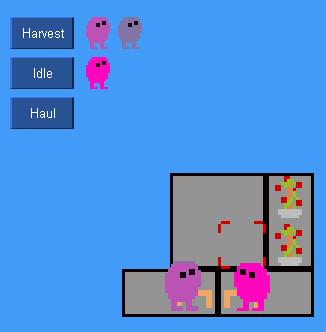
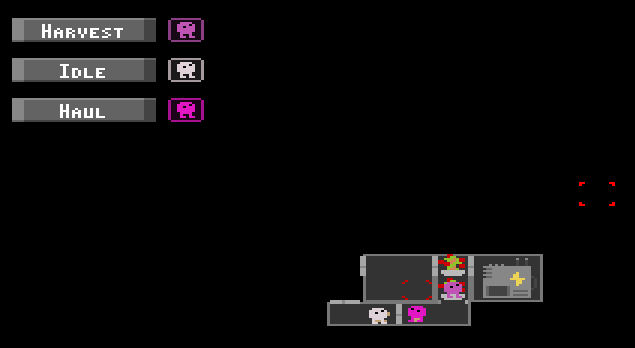
So yeah, not great. I don’t remember the exact order of events at this point, but I think I decided pretty quickly to try to make 12 small games over the year in total instead of trying to make one game every month. As for the weekly schedule, it seemed that since the issue was mostly feeling tired (and a decade of getting used to being a night owl), I was better off trying to live with it for the time being, especially because on top of tiredness I was noticing a slightly concerning lack of energy to make things. I did eat more than a half of a Carolina Reaper chili, though!
I had a plan for an April’s Fools game (two, in fact!) but the aforementioned lack of energy posed a fairly serious obstacle because I couldn’t muster the will to make either game happen on time. Luckily later in April I participated in Nordic Game Jam, which allowed me to actually finish a project, RUDE CHESS. I guess this triggered further productivity, because over the weeks following RUDE CHESS I managed to also finish It’s A Me, Baba Is You XTREME (one of the two April’s Fools games), Baba Friend and Keke in the Caves of Peril. Yay!
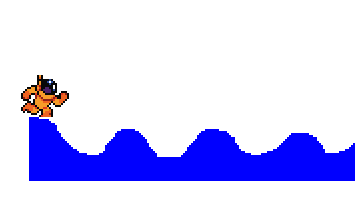
Before NGJ I started having constant restless leg syndrome, which further caused trouble with sleeping and keeping my daily rhythm straight. I often had to tire myself to get any sleep at all, and after the above burst of productivity, over the Summer I fell into a serious lull in motivation, resulting in me stopping bi-weekly gamedev streams and not really feeling like working on games at all for ~3 months. Ugh!!! I did manage to do some paper puzzle design and comics drawing in the meantime, but something was seriously not right.
October drawing close, I was contacted about a plan to make a small bundle of Halloween-themed games. This seemed like a potentially good way to get back on track gamedev-wise and I agreed, deciding on a whim on my game idea (or maybe it was more than a whim, I can’t remember. I think I had come up with the idea slightly before and decided to use it because it seemed funny?) Around this time I also had some blood tests taken and it turned out that I had a serious iron deficiency both in terms of hemoglobin and body iron reserves. And would you believe it, this turned out to have been the issue all along: getting some extra iron gave me motivation & energy back, and the restless leg syndrome went away, too! What’s funnier, a friend had recommended having my iron levels checked just before this (advice which I didn’t heed). Lesson of this story is: don’t get iron deficiency.
With the iron issue sorted out, I managed to finish The Plumber Thing, and this then led into a bunch of unrelated small games: Mamono Mower, Cavern Sweeper, Babataire, Babataire EX, a rerelease of Cavern of Flight, a rerelease & update of Once in Space, a holiday update to The Plumber Thing, some paper puzzles and finally It’s A Block-Pushing Game, fulfilling the goal of the year (or not, depending if the rereleases count). Overall I’m really happy with this year’s productivity, which is a bit surprising considering the iron deficiency. I also recorded a playthrough of a game I liked as a child, Lost Valley.

There are a couple things that were left somewhat or entirely unfulfilled over the year:
- Most of the games I did end up making weren’t part of the original list of monthly games. As stated, most of those were too scope-creepy for this project, but nonetheless.
- My sleep schedule is still mostly terrible, and I didn’t get enough exercise this year, spending most of the time sitting at my computer.
- I didn’t paint almost at all! And I mostly drew just the usual 4 comics I make annually for the student magazine. I mean, that’s definitely something, but I’d want to do some watercolours again.
And now, what’s planned for the next year?
- I’ll keep making some smaller games, although this time without an explicit count I’d aim for. There are a couple ideas I think I should be able to get done with semi-limited trouble, so hopefully at least some of those can become reality.
- It has started to feel that working on ESA2 might actually be fun again. Maybe? We’ll see! I’ll try to make ESA2 my main project next year, and actually get that thing somewhere instead of it staying forever in a limbo of sorts.
- The weekly streams will return; hopefully this time I won’t lose steam halfway through.
- I think it’s time to move on from Baba Is You, at least for the time being. Next April I’d have spent about 6 years of my life around Baba, and while it’s been largely an enjoyable ride (and I do have Baba-related ideas for the future, about which I’ll post when they’re ready to be revealed), it’d be nice to feel that the game as it is now is more or less a “finished” product. Note that this doesn’t mean that I won’t do anything more with/to BIY, but rather that I’d wish to mentally move on from the game and get the feeling that it’s where I want it to be.
- My internal deadline for getting my master’s degree in Psychology has been set to the beginning of April. There’s so little left!
- I’ll try to exercise more.
Here’s a list of the games released this year, alongside the source of inspiration for them (if I can remember it):
- RUDE CHESS (A combination of pondering about randomness as a puzzle mechanic and my earlier No More Sweden 2018 entry, Chnakess)
- It’s A Me! (A joke I made in AuthorBlues‘ Twitch stream chat and then realized sounded actually funny)
- Keke in the Caves of Peril (My entry for Ludum Dare #48 finished and polished)
- Baba Is You XTREME (Idea for an Aprils’ Fools version of Baba Is You)
- Baba Friend (Based on that old desktop sheep toy, I’ve wanted to make one of these since forever)
- The Plumber Thing (Can’t remember the exact thought process leading to it)
- Mamono Mower (Exuno, Goost & Maurice from the Mystery Tournament community joked about odd combos of genres + the community has an inside joke about Lawn Mower, a NES game. Heavy inspiration from Mamono Sweeper)
- Cavern of Flight rerelease (A 2016 Ludum Dare entry, which I edited slightly to remove some game-breaking bugs and rough edges)
- Once in Space 2022 (Updated version of Once in Space from 2011, which in turn was a remake of Once in Space from 2007)
- Babataire (An idea borne out of Cluj solitaire, which I saw in the Zachtronics Solitaire Collection)
- Cavern Sweeper (A separate concept for Mamono Mower that I wanted to explore but removed from the lawn-mowing theme)
- Babataire EX (A serious attempt to combine Baba Is You and solitaire)
- It’s A Block-Pushing Game (Possibly started as a chess-themed sokoban idea? Can’t quite recall)
Maybe that’s enough of that?
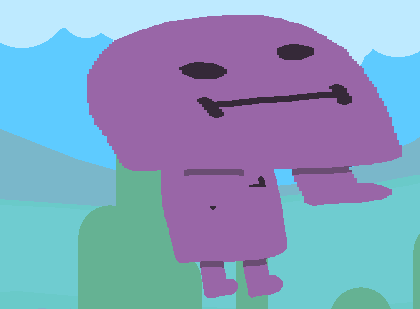
Posted on 2022-07-27 12:51
La-Mulana is a game I like a lot and that inspired me a bunch. I really enjoyed the second game, especially its soundtrack, but when it comes to the first, I always preferred the “classic” version, i.e. the original MSX-like game, over the remake. The remake looks great and adds a metric ton of quality-of-life upgrades, but the original has also a great style of its own and honestly I quite prefer the soundtrack there.
Anyway! When there was just La-Mulana classic, I found a random website that listed a bunch of info about the game, as well as a download link to the game’s official jukebox. This being La-Mulana, a special password was required to unlock the full soundtrack even inside the jukebox. I’m not sure I would’ve had the patience to find it on my own, but luckily for me the password was listed on the website. I haven’t been able to find the jukebox on the internet later, once the remake came out; I wonder if it’s still available via some official means?
A cool detail about the full jukebox was that it features dev commentary from Naramura and Samiel for every song. The commentary is in Japanese, and in the past I ran into the problem that if I tried to copy the text from the jukebox, differences in encoding would render it unreadable. A Japanese-speaking friend helped me solve this some years ago, but I never bothered extracting & re-encoding the entire commentary until now.
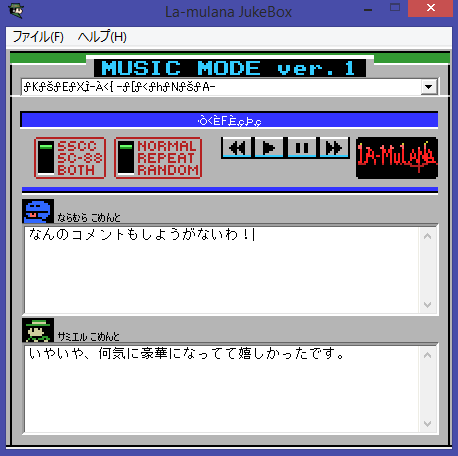
I’ve now extracted the entire thing and run it through Google Translate. The results aren’t very convincing, but maybe I can eventually get an actual translator to go through the Japanese text to get a better version. For now, I’ll link both the Japanese text & the Google-translated versions here. Note that all songs titled “Extra” (as well as some words the end of the final “fearless challenger” song’s title) were in Japanese, but because they were on a drop-down menu, I wasn’t able to copy-paste them in order to get their re-encoded versions; I decided to instead just make up placeholder titles.
Here’s the Google-translated version.
Here’s the Japanese version (UTF-8).
Here’s the version with the original encoding.
Enjoy!
 22
22  1
1
Posted on 2020-12-31 06:37
I was asked about staying motivated when working on a game project; specifically, I’ve mentioned several times having learned useful lessons on motivation from Nicklas Nygren, and I was asked what exactly I had learned. I ended up writing quite a few words about this, and I thought I’d post them here because why not. Here goes:
Initially I had a huge problem with keeping myself interested in a game project; I wanted to make big, ambitious games but lost motivation, usually really fast, and abandoned projects because of how cool mental images of other projects seemed, even if I ended up not really doing anything towards those, either.
Over time this has gotten a lot better, and there are at least 4 major reasons responsible for this that I can think of; one of them is the one I learned from Nifflas and others come from other sources. I’ll start with the two more obvious, mundane and “boring” ones:
- I’ve grown older. Part of the initial trouble was just that I was a pre-teen or teenager and had a generally very impatient state of mind. Some people might be different as kids, but for me maturing a bit helped because it gave me a better ability to resist impatience and short-term lack of fun. For reference, I was almost 23 when I felt like I had the biggest improvement in staying motivated (due to the next point.)
- I’ve had previous successes to encourage me. There are probably lots of aspects to this, some of which I might not be aware of, but I feel that even when I still had motivation problems, getting something actually finished worked in my favour in proving to me that that is possible at all; and using that proof as encouragement allowed me to approach slightly more ambitious ideas with the assumption that they might not be insurmountable. Especially useful here were my two early “largest” projects, Floating Islands Game in 2008 and Environmental Station Alpha in 2015. The former had only 35 levels but they were by my standards very detailed, and while working on the game took a long time due to phases of lesser interest, I feel that the project was part of this process of slowly building confidence in my ability to finish things. ESA was my first personal commercial game, and its development took 3 years due to my interest lapsing every so often, but (due to the reasons listed here) I managed to come back to it despite the lapses and get it done; ESA was large enough a game that I feel that after its release the motivation issue was very significantly diminished.
- I’ve learned to avoid what I once saw an article (on The Daily Click) call “Big Game Fever“. You know those game ideas that are mega-ambitious and seem like they just ooze really cool stuff that’d be so much fun to work on and see implemented? There’s a specific category of “dream games” that are extremely unlikely to ever get finished because the dream about them doesn’t include any of the bugs, issues, difficulties and design problems and concentrates instead on the inspiring, elements that are fun to think about. Some people can take a dream project like this and slowly make it a reality, but for the most part these kinds of game ideas have seemed to me like tempting dead-ends where I might get lured to abandon my existing projects to chase after a such an idea, only to lose motivation once the realization about the true workload that’d be required of me becomes apparent. Or what’s even more common, as soon as I open a new project to start this dream idea, I realize that I don’t really have the motivation to even begin because the things I was dreaming about are so late in the process of implementing everything that would be needed. It’d be disheartening to outright tell myself that these kinds of projects will never be made, but I’ve tried to make myself aware of this pattern and while I allow myself to keep dreaming and thinking of these kinds of game ideas, I keep reminding myself that I’ll get to them eventually, but not now. And maybe in some cases that’ll be true? Either way, thinking about these overambitious ideas can also bring inspiration for other projects, so that’s nice. [The article in question can be found here.]
- Last but not least (this is the specific bit I learned from Nifflas): if you only work on a project when you have motivation or interest towards it, it’ll take a long time to get it done because there’ll inevitably be spots that aren’t fun to work on in the slightest but that nevertheless need doing. Therefore some method to get things done even when not feeling like it is needed; building a method of getting at least a little bit done every day (or every day you intend to get work done, that is) can be very very useful, because it means that the project progresses even during the lapses in interest, even if the progress is slow, and that you don’t mentally allow yourself to let go of the project and move on to other, seemingly more motivating projects. In some ways this method can be as simple as just telling yourself “I need to implement X; today I’ll do this small sub-part Y of it, and if I get that done, I can consider the day successful” and thus allow yourself not to be motivated while still getting a bit forward. Potentially once X is implemented, there could be a more fun thing on the list next that renews your interest? Obviously this has the caveat that sometimes a project e.g. turns out not to be as interesting as you hoped in general and the interest just never picks up again; it might be a hurdle to separate this from cases where the interest is just momentarily gone, but I’d imagine that there are signs that you can use for differentiation (for example what elements come to mind when you consider why you’re not feeling like working on the project.)
As an addendum to that last point, for me personally to-do lists have turned out to be great tools for keeping myself on track during times of less interest. This might be obvious, but I want to specifically mention this because I know some people don’t feel the same way and because there are specific tricks I’ve noted related to to-do lists that facilitate the positive effect. Namely, I’ve noted two types of unuseful/harmful to-do list entries that I need to avoid: large wholes condensed into a single entry, and ambiguously-scoped entries.
The former is bad because when your to-do list says “implement feature X”, you might spend a day working on said feature and at the end of the day look at your list and think “I implemented sub-features Y, Z and A of X, but the feature itself is still a bit buggy/unfinished”, and thus not get to mark the entry as done and not get the encouragement of feeling that the project went forward. Therefore for me it’s useful to break down every point into as tiny sub-entries as possible, so that when I actually get something done, it’s also reflected on the to-do list and I can get the “deserved credit” for work I did.
The second harmful type relates to to-do list entries that are vague and don’t have a well-defined endpoint. These for me are usually written like “think about X” or “try to figure out solutions to Y” and often relate more to game design issues than concrete coding problems. These are bad because if your goal is to “try to think about something”, you can technically spend forever thinking about it and still not be done in a meaningful sense. Of course at times you might find an answer you’re happy with and be able to state with confidence that you thought about it and found a solution; but oftentimes (for me at least) answers to design problems form over longer periods of time while slowly mulling over them in the back of my head. Thus these kinds of entries can again create a sense of “I’m not getting this thing done” and lessen motivation. Then again, you often do need to consider these more vague, more abstract design matters that might not have definite solutions; I’m not entirely sure how to make those work in the context of these to-do lists.
Lastly, I want to point out that what I’m saying here isn’t meant to be taken as some kind of encouragement to crunch; the point of my advice isn’t to answer the question “how to work and stay motivated even while burned out or on vacation”. It’s important to also decide times when you do other stuff, both because of your own health but also because it’s ultimately usually beneficial for your motivation, inspiration etc. as well. These points are more meant for days when you’d technically “want” or intend to work on your project but also don’t feel like it.
And that was it! I hope this was useful to someone.
[I later made a YouTube video listing basically these points; you can watch it here.]
 4
4  2
2
Posted on 2019-02-14 01:51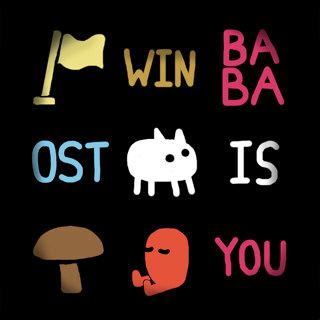
Hello!
There have been a couple streams since the last time I did a “”””weekly”””” update, but for whatever reason I couldn’t muster the energy to make proper blogposts to commemorate them.
Anyway! Things have been going semi-swimmingly, Baba-wise – the game is now feature-complete (to an extent), and we’re just handling some final timing and business stuff related to releasing a game. Baba will be on Steam, Humble Store, itch.io and Nintendo Switch™, and it’ll support Mac and Linux on top of just Windows! Huge thanks to MP2 Games for making this large a selection of platforms a possibility (by porting the game). An inevitable result is, of course, that there’s way more stuff to be handled before release. We’ll see how everything turns out.
A cool thing about Baba is that this time I’ve made the OST by myself! This resulted in a huge mess right before finishing the game, but has otherwise been pretty cool and confidence-boosting. It also means that I’ll get to set up a Bandcamp page! (And deal with “mastering” sound, what does that even mean)
As for the “huge mess”, we were a couple minutes away from calling the game done and sending it forward for further approval when I notified Mathias (the person behind MP2 Games) about worse audio quality on other platforms. Pretty soon it turned out that the issue was in my computer only, and the culprit was the AudioWizard program on my control panel having been set to Music Mode by default. I had spent a bunch of time trying to remove any involuntary audio enhancements from this laptop back in 2015 when I got it, but apparently I had managed to miss this utility that actually did affect my audio output rather heavily. Music Mode in this case meant some combination of equalizers and compressors that e.g. heavily (*very* heavily) emphasized bass. After turning the setting off, the sound quality wasn’t necessarily “worse”, but certain songs had ear-hurting sounds in them that had been smoothed over by the Music Mode, and some songs sounded much thinner without the bass boost.
I went into full emergency mode and contacted some very talented audio designer friends in seek of help. In the end we realized that I can just run the audio through the Music Mode effect and re-record the adjusted sound using Stereo Mix to get the bass-boosted result. However, the earlier bass boost had also brought some uncomfortable audio elements of its own that I had mostly ignored until now, so even with the relatively simple solution I had to spend some 3-4 days editing and re-mixing everything, especially since the effect also affected SFX. Mathias very kindly implemented a batch tool for me so that replacing the SFX wasn’t quite as time-consuming as it otherwise would’ve been.
But that’s now history, and there haven’t seemed to be any new massive hindrances to handle. I’ll be going to GDC in March both for Baba and as a part of the Nolla Games team to promote our upcoming game, Noita. I’ve also ordered some new Baba-related merch to celebrate the occasion. I just wish flying wasn’t such a planet-hurting move. Same for the merch on a smaller scale, actually.
I’d kinda like to do an image-heavy update as an apology for continuously not managing to keep this blog alive, but this new WordPress system is a bit scary and I have a headache so that might have to wait for a later necromancy post. I’ll try to keep the blog updated with new Baba info, and ESA2 once I finally get that far.
P.S. I’ve been enjoying Cultist Simulator by Weather Factory a whole lot again. Very inspiring, beautiful-sounding and -looking!

 3
3
Posted on 2017-05-05 01:29
I was asked these questions on Twitter and since Twitter is Twitter with its letter limits, I decided to import the questions here and answer them more elonquently:
What are the key features a 2d platforming game should have?
“2d platforming game” is a fairly abstract concept and defines only a very small part of a game’s design; there are 2D platformers that vary from each other greatly, and most of their defining features don’t stem from being 2D platformers but rather from other things. Technically I could try to find some defining features that 2D platformers should have that aren’t dependent on other factors, but the list of said features would be pretty limited. Let’s try:
Things a 2D platformer needs to have:
- A playable character
- Sideways perspective
- Obstacles that block your way or offer something to stand on
- Gravity (although even this can be done without)
There are also things that 2D platformers usually have, such as collectibles, goals, failure conditions, enemies, HP, lives, levels, environments etc., but with a strict definition none of them are required to call a game a “2D platformer”. (Note that the list of things 2D platformers need was just something I made up on the spot, I’m sure there are valid arguments to reduce even more things from it!)
If someone were to learn game development via making a 2D platformer, I’d say that using something like Super Mario Bros. as a guideline on what’s expected from such a game could be the best way to go, because it contains all those strictly platformer-related concepts listed above, but also lots of handy learning opportunities in form of those other, less definitive but nonetheless handy things such as coins, score, level progression and losing.
What’s the best art style for a side-scrolling platformer?
This is a very subjective question! The definition of “best” definitely hinges a lot on both the budget and the personal taste of the developer. The game screen should be easily readable, i.e. it should be clear what is background and what is a wall, an interactable object etc., but there’s a huge amount of options to choose from in terms of unique artstyles that achieve that, and whether one of them is better than the others depends entirely on the opinion of the player/developer.
I’m personally rather biased towards retro-style pixel art graphics with stretched pixels (see: Cave Story, Eternal Daughter, Maldita Castilla). It’s important to note, though, that even stretched-pixel pixel art doesn’t have to look retro (see: WitchWay, Fez, Hyper Light Drifter for a non-platformer example) and that non-stretched-pixel pixel art is definitely also an option and can be achievable by a smaller team (see: Within a Deep Forest, IJI). Outside of the realm of pixel art things require a bit more work pretty quickly which might not be worth it for a smaller team, but on the other hand the results can be sweet (see: Saira, Braid, LIMBO). Taking a nonstandard approach to the artstyle might also be a good option (see: An Untitled Story), so nothing’s really that clear. These are obviously just my own personal tastes!!
If I were to suggest an artstyle for someone making their first 2D platformer or aiming to learn game development, I’d probably recommend something like the visual style of the NES Megaman games; stretched pixels, limited colour palette, very high readability, fairly easy to work on, tile-based background art to lessen workload and so on.
What type of music would go well with a pixel art style?
I don’t think I can really answer this properly. “Pixel art style” in itself is such a vague concept that depending on other factors pretty much any kind of music could go well with it. There are good examples of orchestral(-style) music (see: Owlboy, Titan Souls, Gods Will Be Watching), retro-style music (see: Cave Story, Spelunky classic, Shovel Knight), music with more modern instruments that I can’t think of a good category name for (see: Nuclear Throne, IJI) or minimalistic electronic music (see: Within A Deep Forest). Games like Undertale combine stuff from several musical styles very successfully, and some utilize existing music as their soundtracks (see: Space Funeral, Hotline Miami).
Again, retro-style chiptunes might be the easiest way to go, but really the answer to this question is pretty much “anything”.
EDIT: I actually haven’t played Owlboy and added it in because I checked that it has an orchestral soundtrack and pixel art graphics. I’m fairly certain that the musics fit the game but I implied too much up there. My apologies!
Posted on 2015-12-30 22:18
Well then! It’s the end of the year, as well as the beginning of the 7th year of my blog! Wow, I actually hadn’t ever counted how long the blog has been around, but that’s pretty cool, I’d say. Lots of stuff has happened over the past year (and sadly most of it not in this blog). Anyway!
Environmental Station Alpha was rated the Best PC Metroidvania of 2015 at metroidvanias.com, along with Axiom Verge and Castle in the Darkness! I’m really glad about the game’s generally pretty positive reception, even despite all the little problems and quirks that unavoidably accompany a larger game designed by a single person. As an extra-cool thing, SmiteTV, who was one of the first to stream the game, has returned with the intention to do a full LP along with his co-commentator, Madithen. There have been lots of neat LPs of the game already, of course, but what makes this one especially intriguing is that it’ll probably be headed to lparchive.org once it’s completed! Sweet!
This year has been pretty interesting also in the sense that in a post-ESA world I’ve found in myself the ability to concentrate on game projects for longer period of time, even during those lulls in interest that have previously driven me away from a project for months; this is neat and makes me more certain about future projects. The weekly stream I’ve been doing since …April? has also helped a lot, although I’ve also noticed a tendency of hurrying and not concentrating enough while making games on-stream due to the feeling that I need to show “cool stuff” instead of working on more technical things.
I’ve been feeling really anxious at times about things happening in different parts of the world over the past year; it definitely feels like there’s a lot of anger, frustration and bad will bubbling in people’s minds everywhere, and I’m scared of the prospect that there are people who believe that hurting others is justifiable who might eventually decide to take the law in their own hands somewhere. Let’s hope that doesn’t happen!
(The year has also had lots of great things going on, though!)
To cap this weird end-of-the-year post, here’s a list of the games I’m working on:
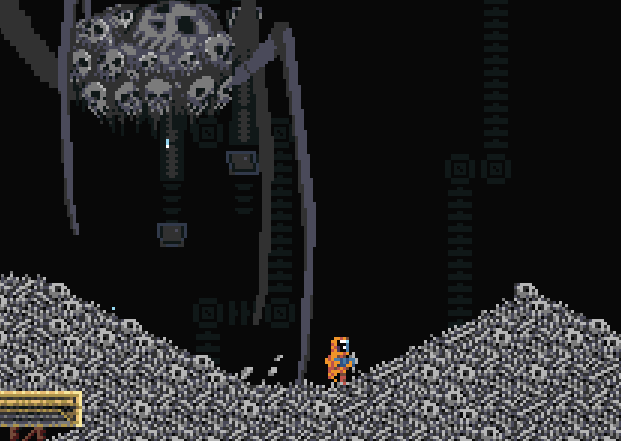
1. The new metroidvania – It’s the thing I’ve been mostly showing while streaming. I couldn’t help it and ended up starting to work on a new metroidvania as soon as the old one was done. What I said earlier about hurrying and not concentrating enough has affected this project the most – I feel it has a lot of potential but I also feel that there are some things that I’ll eventually have to rework pretty heavily to really make the game work. Mainly graphical stuff, though.
2. Snake game – I’ll post screenshots once I get a bit further with the project, but people who have watched the stream have probably seen bits of this. Flying on a plane and seeing snakes, that inspires me a lot. I’ve been very excited about getting this project forward! Alas, there’s a lot of stuff in the engine that’s wonderfully complicated and I feel there’ll be several problems to solve before I’ll get the game to a truly polished-feeling state. Right now there’s one aggravating graphical bug that I dread to touch.
3.-6. Various smaller games that might need a bit more work before being “announced” – Yeah, this list is pretty silly because most of these games are in a pretty early form right now. But yes, there are some secrets projects I’m slowly also developing! These are mostly smaller, too, so it might be that I’ll finish them before my next “larger” project is done. Who knows!
Happy new year!
Posted on 2015-05-22 01:37
Oh well! It’s been about a month since the game’s release and things have been going rather swimmingly, I’d say. I kind of wanted to write down some thoughts in regards to the game, it’s reception and so on. There will be spoilers, but I doubt anyone who hasn’t experienced the game some way (through Let’s Plays, Streams or actually playing it) will read this.

Where everything started; the original art to test a 32-colour palette
It’s been very interesting to see people’s reactions and feedback on the game’s difficulty. Most of the testers were people who’ve played a lot of games, so I knew beforehand that the feedback I got before release was somewhat skewed. After release I did get a lot of feedback & criticism on this aspect, and eventually implemented the easy mode as a response for the criticism. I felt that since the game had already been completed by some people who also told me they had had fun playing the game with the “original” difficulty, it wouldn’t have been a good idea to outright change the basic game experience but instead apply those changes into a whole different mode.
People on the Steam Community Hub made a really interesting point about why they felt the difficulty was frustrating – instead of the game being tough all the way through, there was seemingly a large difficulty discrepancy between boss fights and the rest of the game; this way there were players who didn’t mind the overall difficulty but would get stuck in singular encounters. Hopefully the current version works better in this sense, though. :)
I love large boss fights in games, and the game really reflects that, at least in terms of boss quantity. Boss fights can be much more unique in nature than many other parts of games of this genre, and since they’re fought (usually) only once, it’s easier to concentrate on making that singular encounter memorable. I’m especially fond of bosses that work like puzzles, which is of course a staple in adventure games. That said, there are 3 things I wish I had concentrated on a bit more while designing the bosses.
1) The actual diversity in boss designs. Many of the bosses use a similar base concept of the boss itself being stationary, and while the nature of this stationary-ness varies between them, I feel I could’ve worked out some better solutions for this. According to the general feedback people have liked how different the bosses are as-is, but of course one could always improve! I actually even changed two fights after designing them once (Station AI and Tomb Spider) to reduce the amount of bosses that do not move by themselves at all (although the latter of the two needed a redesign for other reasons as well).

What the Tomb Spider replaced. I’m not sure why the game has so many eyes.
2) The boss “puzzles”. As it is, those are nearly nonexistent in Environmental Station Alpha. My approach to game design is very freeform and I didn’t really think of any deeper design concepts while working on the game content (apart from some exceptions). This along with the fact that it’s much easier to design a boss that you just need to mow down made most of the boss fights not require that much problem-solving rather than “just” dodging and learning the boss patterns. I think I did a pretty good job compensating this lack of puzzles in the fights with interesting patterns and attacks, but again, there’s always something one could improve. :)
3) The boss difficulty curve. I only realized this after the release – since there are two immensely powerful items (Dash Booster X and the Supercharge Module), all bosses that can be fought after getting those two (or just the Supercharge module) become extremely easy. This creates a rather funky pattern where in the beginning the bosses get progressively harder (with Serpent 5 and Overgrowth being the two most difficult ones), but the ones after Multicore can be rendered practically harmless by getting the Supercharge module. My intention was that most people either wouldn’t care about the optional powerups enough or would want to keep some challenge and not use the more powerful things while fighting, say, the final boss, but of course since the game never explicitly says “btw, these are REALLY POWERFUL, try beating the bosses without them!!!” it’s understandable that most players do not approach them this way. On the other hand, maybe there’s something cathartic to be able to defeat the latter bosses with ease after the early struggles.
Talking about puzzles reminded me of some other stuff I’ve been thinking about before and after the release. The game was made using a rather crude custom-made level editor because Multimedia Fusion’s built-in level system is really terrible (imagine every room of Super Metroid having all the game code stored internally, so that if there’s a bug, all code needs to be copy-pasted to every single room (of which Environmental Station Alpha has over 200)). Since I wasn’t very good at using MMF 2 when I started working on the game, I made the level editor to only support adding and removing tiles & putting enemies and such on the map. There was no cutscene editor or ability to add custom stuff to rooms in the editor itself; everything of that nature had to be manually coded in Multimedia Fusion. This made implementing cutscenes a huge pain, which can be seen in how few of them there are, although it of course doesn’t concern cutscenes such as the intro or the ending, since those don’t take place in the actual game world.
Due to these restrictions the in-game puzzles had to be hardcoded as well, which proved to be pretty difficult and frustrating. I hadn’t really planned that many puzzles beforehand, which caused a similar effect as with the boss design that since coding puzzles into the game was such a pain, in the end there ended up not being that many of them. At some point I coded pushable blocks to the game, and these can be seen in places like the triple-shot room; the temple was meant to hold some more traditional block-pushing puzzles along with more meta “think outside of the box” -type ordeals. However, I eventually redesigned the whole temple because it wasn’t really up to the standards of the rest of the game, and decided not to include any block-pushing in time finished product. Some of the original temple puzzles can be seen in the post-endgame content, though.
It’s easier to point out things that didn’t work than things that did, but there are some things in the game that really positively surprised me. The biggest one is the hookshot – originally I disliked the idea of using a concept as ‘classic’ as a hookshot, testing out some rather weirder ideas, as seen in this gif:
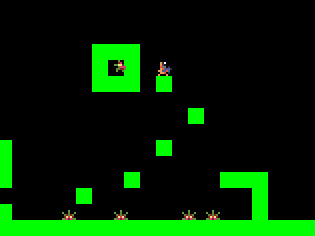
After some fumbling and realizing the hookshot would be a pretty cool thing after all, I implemented it in the easiest way I knew back then. I didn’t really think much of it at the time, but I was content with how it worked. However, during testing and after reading actual player feedback it became apparent that the hookshot had turned out to be really satisfying to use, allowing for some pretty insane ~~SPECIAL STRATS~~ among other things. Part of the satisfyingness comes of course from the sweet latching sound Joonas & Niilo made for it! I’ve always really loved games where a somewhat basic item/powerup can be used or exploited to do really crazy stuff – a good example is the cape in Super Mario World, which is pretty handy even when used just to slow down the player’s fall, but becomes immensely powerful at the hands of someone who knows how to fly properly with it. Another classic example is of course shinespark in Super Metroid and other 2D Metroids that include that mechanique. The hookshot isn’t really comparable to either of these examples, but I’m still happy that it turned out to be much more useful than it initially seems! :)
There were some other powerup and gameplay ideas I toyed with but scrapped in the beginning of the design process. One of the cooler ones was zero-gravity, which would’ve been present in certain areas that were exposed directly to space. Since the player is a robot, the lack of oxygen isn’t a problem, but in these sections the player would’ve been forced to shoot in different directions to propel themselves. I’m sure the same concept had been done elsewhere already at that time, but it would’ve fit the setting. The actual reason this mechanique was scrapped is because of certain coding problems (a really silly reasoning, in hindsight! Now I almost feel a bit sad for not keeping that system in). In one of the earlier drafts of ESA, the game was set on a wreck of several smaller space stations & spaceships, requiring the player to use this zero-gravity movement system pretty often. Here’s a screenshot of said iteration:
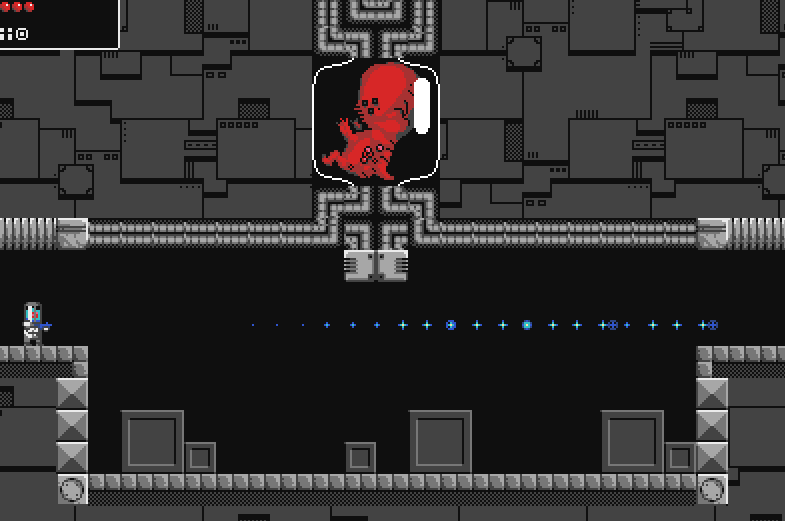
That screenshot also portrays nicely the design of the main character; they were always supposed to be a robot, but in this higher-resolution picture you can see the “brain-tank” -design better. The sprite of the player character in ESA used to be a bit larger, but I resized it to make the scale of the station feel bigger, and to make the player’s collision mask a bit less ambiguous. Here’s the original sprite:
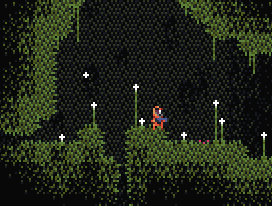
Somewhat related to the player’s abilities changing over time, the dash powerup actually started off as a bomb! It was fun to toy with but since I didn’t want any random drops in the game, in the end it didn’t really fit in.
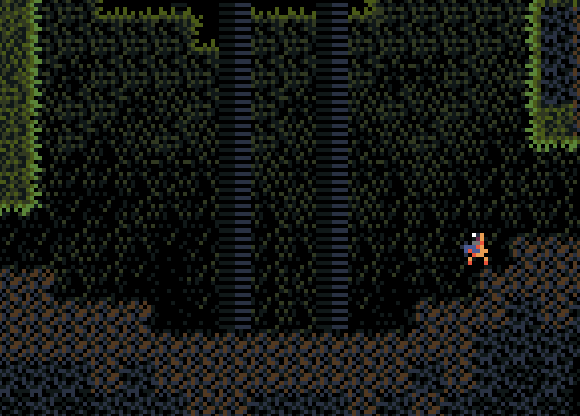
The next iteration of the powerup was a shield the player could use to prevent damage. The problem with this was that I couldn’t decide how to map activating the shield into the existing button layout, along with a set of other problems such as how to portray its length and cooldown, if it would damage enemies or just deflect bullets etc. You can see the somewhat confusing way the shield worked here:
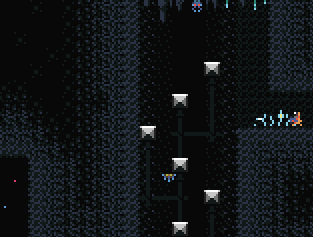
In the end, I took the “makes you invulnerable & damages enemies” idea from the shield and incorporated it in two powerups, the plasma field & the actual dash. Here’s the dash in its original form:
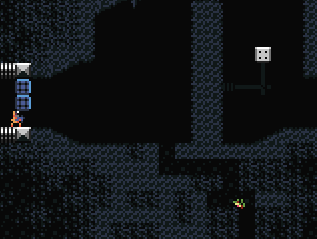
I didn’t plan the story that well beforehand. I had had some story ideas before of a virus that infected robots and made them act so as to infect more robots; at some point I was considering a game where the player is the aforementioned virus and must move between robots, gaining more power in order to target larger and larger robots. The idea is still kind of cool in my opinion, but it would require an engine and game world fully built around this hijacking system. I remember having this mental image of a cutscene where the player infects what would later become Serpent 5 in ESA and “ride” it to freedom from wherever the game would’ve taken place. In this way, the basic form of the story was there to some extent even if I didn’t really think of it that much. The biggest problem such a leisure style of design presented me with was figuring out a justification for the player to explore all the areas of the station. The journey from the underwater sector to the jungle sector proved to be especially tough to explain, solved in the end with two halves of a single journal. I think this design issue can still be seen somewhat in that many players seem get lost at some point about halfway through the game.
One fairly interesting thing I noticed after the game’s release was that nearly everyone I saw beat the game thought that the reason the ending is kind of a downer is because they hadn’t collected everything yet. I can understand the reasoning behind this, but since I had decided on the ending to be somewhat bleak well beforehand, I didn’t foresee at all that people would of course assume for there to be some other, happier ending. If one thinks about it, in a sense only the normal ending is actually sad – the robot “dies” in some way in any case, but in the other endings this doesn’t put others at risk. Thinking this way, the fourth ending (accessed by beating the game normally after finding the secret ending once) might be the ‘happiest’ one since in it there’s no chance of the virus spreading any further. I find portraying death as something that isn’t inherently bad interesting, and in my opinion there could be more games where someone dying isn’t necessarily a mark of the player messing up and needing to, say, find all the secrets, but instead just the way things happen to be. Something something Final Fantasy VII something.
The post-endgame puzzle section I had been pondering about for a long time. I really really love those kinds of obscure ARG-ish puzzles that the community has to collaborate on to fully solve; seeing people eventually figure out stuff like the secret stars in Braid is really amazing in my opinion, and even though I initially didn’t plan to include this much post-endgame content in the game, I did feel that it’d be cool to try to get some of the same feeling of mystery that makes the player go “I don’t understand all this, but there’s apparently much more here than is initially apparent” in the game. Being able to go all out with the puzzle design made designing them much easier compared to the relatively nonexistent puzzles of the normal game content, and I had a lot of fun coming up with some really mean tricks. The only problematic thing was that since I wasn’t totally certain how many players the game would garner, I wanted to make sure that at least someone would find out about this secret crazy puzzle stuff, and while doing so made it a bit too easy to get started with it. This resulted in a situation where pretty much every player stumbles upon the keys and whatnot and thinks “oh, this is what I must do next”, only to find some intentionally very obtuse puzzles and possibly find them off-putting since they’re so different from the rest of the game. After realizing this I did rework some of the hints to be a bit more reasonable, though. I’ll just have to make a clearer distinction between “normal” endgame stuff and “hidden” endgame stuff next time!
Fun fact: originally the very very last puzzle of the game required the player to have exactly 100% completion rate to get the secret ending; any more or less and they’d just lose instead. Getting to the secret ending with 100% requires skipping something in earlier parts of the game, like a diskette, meaning that the player would most probably have needed to re-do the whole game with this specific puzzle in mind in order to “solve” it. I still like the idea, but it will need to wait for some other game, haha.
In the end, I think I succeeded pretty well in doing what I set out to do, i.e. make a metroidvania with lots of bosses and a large world to explore. I’m thinking of sometime making something a bit similar, but we’ll see what happens; it’d be silly to promise anything at this point.
To end this huge wall of text, here are things I’ll do differently next time, assuming there’s one:
– Less tightly packed map. The world of ESA felt kind of cramped at times because there’s no empty space anywhere and the rooms are generally pretty small. Having more air, even if it didn’t serve any purpose, might help make the game world seem larger and more lively.
– Less powerful powerups & protagonist. By the end of Environmental Station Alpha the player character can literally fly and spam really powerful triple shots. I think this works somewhat well since I took that into account while designing the world, but making the player character more vulnerable and the powerups less overpowered could help make the difficulty curve neater, along with allowing the game to have some areas that are hard to get access to. This could also help make some secrets easier to hide, since the player couldn’t just fly against every wall to check for passages.
– More mobile bosses that appear less often. Reasoning explained earlier; I’d especially want to experiment with bosses that aren’t just a single unit but instead two or three co-operating entities.
– More capable level editor to allow for custom cutscenes and some scripting-like features. Pretty self-explanatory.
Thank you for reading this, I hope the text was interesting! I’ll start streaming the development of my next game once it gets far enough to be shown off; hopefully that’ll happen pretty soon. I didn’t really talk about the audio here, but obviously thanks to Roope Mäkinen for the game music, and Joonas Turner & Niilo Takalainen for the sound effects.
 2
2